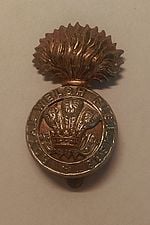 The Royal Welch Fusiliers was a line infantry regiment of the British Army, part of the Prince of Wales’ Division. It was founded in 1689 to oppose James II and to take part in the imminent war with France. The regiment was numbered as the 23rd Regiment of Foot, though it was one of the first regiments to be granted the honour of a fusilier title and so was known as The Welch Regiment of Fusiliers from 1702. The “Royal” accolade was earned fighting in the War of the Spanish Succession in 1713.
The Royal Welch Fusiliers was a line infantry regiment of the British Army, part of the Prince of Wales’ Division. It was founded in 1689 to oppose James II and to take part in the imminent war with France. The regiment was numbered as the 23rd Regiment of Foot, though it was one of the first regiments to be granted the honour of a fusilier title and so was known as The Welch Regiment of Fusiliers from 1702. The “Royal” accolade was earned fighting in the War of the Spanish Succession in 1713.
It was one of the oldest infantry regiments in the British Army, hence the archaic spelling of the word Welch instead of Welsh. In the Boer War and throughout the First World War, the army officially called the regiment “The Royal Welsh Fusiliers“, but the archaic “Welch” was officially restored to the regiment’s title in 1920 under Army Order No.56. During those decades, the regiment itself unofficially used the “Welch” form. The regiment was amalgamated with the Royal Regiment of Wales (RRW) on 1 March 2006, to become the 1st Battalion, Royal Welsh (RRW becoming the 2nd Battalion).
The regiment primarily recruited from North Wales It should not be confused with the Welch Regiment, which recruited from South and West Wales.
History
Henry Herbert, 4th Baron Herbert of Chirbury, founder of the regiment
Regimental Colour of the 6th (Caernarvonshire and Anglesey) Battalion, Royal Welch Fusiliers.
Early wars
The regiment was formed by Henry Herbert, 4th Baron Herbert of Chirbury at Ludlow in March 1689 to oppose James II and to take part in the imminent war with France.
The regiment was deployed to Ireland in August 1689 for service in the Williamite War in Ireland; it fought at the Battle of the Boyne in July 1690, the Capture of Waterford also in July 1690 and the Siege of Limerick in August 1690. In the following year, it fought at the Siege of Athlone in June and the Battle of Aughrim in July.
The regiment embarked for Flanders in 1694 for service in the Nine Years’ War.[6] It fought at the Siege of Namur in July 1695. The regiment returned to Flanders in 1701 for service in the War of the Spanish Succession; it saw action at the Battle of Schellenberg in July 1704 and the Battle of Blenheim in August 1704.
The regiment returned to Flanders in 1742 for service in the War of the Austrian Succession. It was in action at the Battle of Dettingen in June 1743, and at the Battle of Fontenoy in May 1745. It returned home later that year and was sent to Scotland to help suppress the Jacobite rising, where it saw action at the Battle of Culloden in April 1746 before returning to the continent to fight at the Battle of Lauffeld in July 1747.
The regiment embarked for Germany in 1758 for service in the Seven Years’ War. It fought at Battle of Minden in August 1759, the Battle of Warburg in July 1760 and the Battle of Kloster Kampen in October 1760 as well as the Battle of Wilhelmsthal in June 1762.
Sir Yes Sir Military Insignia provides most British Regiments Bespoke Rings, Cuff Links and Dog Tags. Furthermore, if we don’t have what you are looking for please visit out Custom Ring page and have us design exactly to your requirement.

